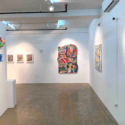GR Gallery opened a few weeks ago “Geometric Heat”, a new group show, exhibiting artworks by four internationally renowned artists: Marco Casentini Jan Kalab, Adam Lucas and Daniel Rich.
This exhibition showcases a new body of 20 paintings, specially created for this occasion. The title underline the specific dynamic approach to art developed by these artists, that use geometric shapes and a renewed inspiration from the “abstract geometry” movement to create advanced and up to date creative compositions that will throw the visitor in a timeless universe of organised vibrancy, thanks to balanced, pattern-like figures, enhanced by a strong dose of refreshing energy.
As explained in the press release, “Geometric Heat” aims to highlight the avant-garde aesthetic approach to geometric abstraction shared by the four artists. A style focused, through the use of traditional media, simultaneously on developing a new geometric formula and using it to push this aesthetic beyond the traditional artistic boundaries. All the artists, even if with different visual accomplishments, share a similar theoretical approach and background that strongly influence their artistic procedure. The eco of a shared passion for historical tradition in the 3-d optical illusion and for both emotional and physical colour theories whispers over their creations, capable to reinterpret this heritage using new approaches, sharp and wide open aesthetic visions and an up to date passion for visual details and content.
The exhibition is on view until August 18 2019, at the gallery located on 255 Bowery (btw Houston & Stanton), New York, NY 1000.
MARCO CASENTINI (Italian, 1961)
He divides his time between Los Angeles and Milan where he teaches at the Accademia di Belle Arti di Brera.The paintings from his first period in Milan are recognised by their typical Lombard colouring. In 1996 starts to travel throughout the United States, mainly in the Western States.The colours and above all, the light, of these States have a big effect on his creativity as he abandons the use of earthly colours and introduces new colours and new atmospheres. He had solo museum exhibitions at The Bakersfield Museum of Art, the Riverside Art Museum, Riverside, California, CAMeC, La Spezia, Torrance Art Museum,Torrance, California, Museum für Konkrete Kunst, Ingolstadt,a nd Mestna Galerija, Nova Goricaand in private galleries in Los Angeles, San Francisco, San Diego, Chicago, Miami, Palm Desert, New York, Sun Valley, Milano, Munich, Frankfurt and Paris.
JAN KALAB (Prague, 1978)
In the nineties, as the country was opening itself to western influences, he became one of the pioneer of the local Graffiti scene, and founded an iconic crew, the DSK. Through Europe, he made a name for himself as Cakes. Next step to the Hall of fame: New York, where he made a big impression by painting whole cars in 2000, alongside with Key and Rome. Around the same time, he found a new way to push his own limits and challenge himself: 3-D Graffiti. Those sculptures lead him to abstraction, a path he’s been exploring through canvas from 2007, using acrylic painting and brushes. Jan Kaláb had his first solo exhibition in 2008 in Prague. Others solos took place in Romania, Argentina, Germania or in the United States. Playing with circles conveyed organic imperfection and swing into his work. Dynamic is also crucial in his recent experiments, when he took pictures of some of his paintings in the streets of New York or other cities.
ADAM LUCAS (US)
Is the artist behind Hanksy who has added to the cultural zeitgeist of street art since 2011. The work of Adam Lucas layers images, text and bold design with playfully acerbic references culled from contemporary culture. Using a loud and elegant colour chord, Lucas simulates the experience of being a city-dweller who’s inundated with visual information and coded advertising subtext. His design is a nod to the synthetic Cubists; however, calibrated to express the distinctive urban street life and popular culture in America. Lucas’ painted worlds possess a density that is both visual and auditory: on the one hand, they pulsate with sounds and rhythms, as if echoing an encounter with music. On the other hand, with their unmodulated colours bound by crisp borders, his paintings allude to the way our eyes absorb the sleek advertising aesthetic that’s secretly pervasive in our daily lives.
DANIEL RICH (Ulm, 1977)
Rich’s meticulous acrylic paintings of the built environment are devoid of human presence, and explore the way architecture and urban space reflect our lived experience and political and social structures. In a labor-intensive process, Rich works from Google images, newspapers, and photographs, translating them into paintings with hand-cut stencils, mixed colour, paintbrushes, and a squeegee to create smooth surfaces. “The architectural image is represented to introduce a dialogue about changing political power structures, failed utopias, the impacts of ideological struggles, war and natural upheavals,” he has said. He translates photographs into paintings that call attention to implicit political and social narratives transcribed in the built environment. The architectural image is represented in his work to introduce a dialogue about changing political power structures, failed utopias, the impacts of ideological struggles, war and natural upheavals.
Author: Fran
Founder and editor of Urbanite. Street Art lover who after the finishing her MA thesis on the Mexican and Norwegian muralist movement in the 1920-50s, developed a fascination for street art and graffiti that eventually led to collaborations with different art blogs, including the creation of this one.







You must be logged in to post a comment.